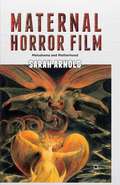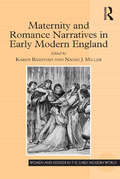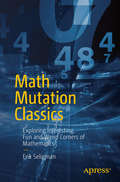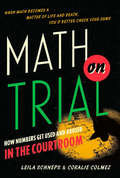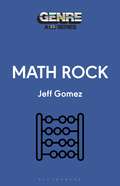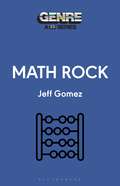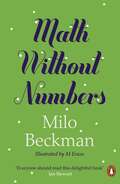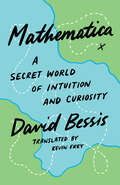- Table View
- List View
Maternal Horror Film: Melodrama and Motherhood
by S. ArnoldMaternal Horror Film: Melodrama and Motherhood examines the function of the mother figure in horror film. Using psychoanalytic film theory as well as comparisons with the melodrama film, Arnold investigates the polarized images of monstrous and sacrificing mother.
The Maternal Imprint: The Contested Science of Maternal-Fetal Effects
by Sarah S. RichardsonLeading gender and science scholar Sarah S. Richardson charts the untold history of the idea that a woman's health and behavior during pregnancy can have long-term effects on her descendants' health and welfare. The idea that a woman may leave a biological trace on her gestating offspring has long been a commonplace folk intuition and a matter of scientific intrigue, but the form of that idea has changed dramatically over time. Beginning with the advent of modern genetics at the turn of the twentieth century, biomedical scientists dismissed any notion that a mother—except in cases of extreme deprivation or injury—could alter her offspring’s traits. Consensus asserted that a child’s fate was set by a combination of its genes and post-birth upbringing. Over the last fifty years, however, this consensus was dismantled, and today, research on the intrauterine environment and its effects on the fetus is emerging as a robust program of study in medicine, public health, psychology, evolutionary biology, and genomics. Collectively, these sciences argue that a woman’s experiences, behaviors, and physiology can have life-altering effects on offspring development. Tracing a genealogy of ideas about heredity and maternal-fetal effects, this book offers a critical analysis of conceptual and ethical issues—in particular, the staggering implications for maternal well-being and reproductive autonomy—provoked by the striking rise of epigenetics and fetal origins science in postgenomic biology today.
The Maternal Imprint: The Contested Science of Maternal-Fetal Effects
by Sarah S. RichardsonLeading gender and science scholar Sarah S. Richardson charts the untold history of the idea that a woman's health and behavior during pregnancy can have long-term effects on her descendants' health and welfare. The idea that a woman may leave a biological trace on her gestating offspring has long been a commonplace folk intuition and a matter of scientific intrigue, but the form of that idea has changed dramatically over time. Beginning with the advent of modern genetics at the turn of the twentieth century, biomedical scientists dismissed any notion that a mother—except in cases of extreme deprivation or injury—could alter her offspring’s traits. Consensus asserted that a child’s fate was set by a combination of its genes and post-birth upbringing. Over the last fifty years, however, this consensus was dismantled, and today, research on the intrauterine environment and its effects on the fetus is emerging as a robust program of study in medicine, public health, psychology, evolutionary biology, and genomics. Collectively, these sciences argue that a woman’s experiences, behaviors, and physiology can have life-altering effects on offspring development. Tracing a genealogy of ideas about heredity and maternal-fetal effects, this book offers a critical analysis of conceptual and ethical issues—in particular, the staggering implications for maternal well-being and reproductive autonomy—provoked by the striking rise of epigenetics and fetal origins science in postgenomic biology today.
Maternal Justice: Miriam Van Waters and the Female Reform Tradition
by Estelle B. FreedmanCelebrated prison reformer Miriam Van Waters made history for her sensational battle to retain the superintendency of the Massachusetts Reformatory for Women in 1949. Maternal Justice provides a compelling biography of this early lesbian activist by moving beyond the controversy to tell the story of a remarkable woman whose success rested upon the power of her own charismatic leadership. Estelle B. Freedman draws from Van Waters's diaries, letters, and personal papers to recreate her complex personal life, unveiling the disparity between Van Waters's public persona and her agonized private soul. With the power and elegance of a novel, Maternal Justice illuminates this historical context, casting light on the social welfare tradition, on women's history, on the American feminist movement, and on the history of sexuality. "Maternal Justice is as much a work of history as it is biography, bringing to life not only a remarkable woman but also the complex political and social milieu within which she worked and lived."—Kelleher Jewett, The Nation "This sympathetic biography reclaims Van Waters for history."—Publishers Weekly "The Van Waters legacy, as Freedman gracefully presents, is that she cared about the lives of women behind bars. It is a strikingly unfashionable sentiment today."—Jane Meredith Adams, San Francisco Chronicle Book Review, Editor's Recommended Selection "This finely crafted biography is both an engrossing read and a richly complicated account of a reformer whose work . . . bridged the eras of voluntarist charitable activism and professional social service."—Sherri Broder, Women's Review of Books "This is a sympathetic, highly personal biography, revealing of both the author's responses to her subject's life and, in considerable detail, Van Waters's family traumas, illnesses, and love affairs."—Elizabeth Israels Perry, Journal of American History
Maternal Megalomania: Julia Domna and the Imperial Politics of Motherhood
by Julie LangfordAncient authors emphasize dramatic moments in the life of Julia Domna, wife of Roman emperor Septimius Severus (193–211). They accuse her of ambition unforgivable in a woman, of instigating civil war to place her sons on the throne, and of resorting to incest to maintain her hold on power. In imperial propaganda, however, Julia Domna was honored with unprecedented titles that celebrated her maternity, whether it was in the role of mother to her two sons (both future emperors) or as the metaphorical mother to the empire. Imperial propaganda even equated her to the great mother goddess, Cybele, endowing her with a public prominence well beyond that of earlier imperial women. Her visage could be found gracing everything from state-commissioned art to privately owned ivory dolls. In Maternal Megalomania, Julie Langford unmasks the maternal titles and honors of Julia Domna as a campaign on the part of the administration to garner support for Severus and his sons. Langford looks to numismatic, literary, and archaeological evidence to reconstruct the propaganda surrounding the empress. She explores how her image was tailored toward different populations, including the military, the Senate, and the people of Rome, and how these populations responded to propaganda about the empress. She employs Julia Domna as a case study to explore the creation of ideology between the emperor and its subjects.
Maternal Megalomania: Julia Domna and the Imperial Politics of Motherhood
by Julie LangfordAncient authors emphasize dramatic moments in the life of Julia Domna, wife of Roman emperor Septimius Severus (193–211). They accuse her of ambition unforgivable in a woman, of instigating civil war to place her sons on the throne, and of resorting to incest to maintain her hold on power. In imperial propaganda, however, Julia Domna was honored with unprecedented titles that celebrated her maternity, whether it was in the role of mother to her two sons (both future emperors) or as the metaphorical mother to the empire. Imperial propaganda even equated her to the great mother goddess, Cybele, endowing her with a public prominence well beyond that of earlier imperial women. Her visage could be found gracing everything from state-commissioned art to privately owned ivory dolls. In Maternal Megalomania, Julie Langford unmasks the maternal titles and honors of Julia Domna as a campaign on the part of the administration to garner support for Severus and his sons. Langford looks to numismatic, literary, and archaeological evidence to reconstruct the propaganda surrounding the empress. She explores how her image was tailored toward different populations, including the military, the Senate, and the people of Rome, and how these populations responded to propaganda about the empress. She employs Julia Domna as a case study to explore the creation of ideology between the emperor and its subjects.
Maternal Modernism: Narrating New Mothers
by Elizabeth PodnieksDrawing on the figure and discourses of the Victorian fin-de-siècle New Woman, this book examines women writers who struggled with conservative, patriarchal ideologies of motherhood in novels, periodicals and life writings of the long modernist period. It shows how these writers challenged, resisted, adapted and negotiated traditional ideas with their own versions of new motherhood, with needs for identities and experiences beyond maternity. Tracing the period from the end of the nineteenth century through the twentieth, this study explores how some of the numerous elements and forces we identify with modernism are manifested in equally diverse and often competing representations of mothers, mothering and motherhood. It investigates how historical personages and fictional protagonists used and were constructed within textual spaces where they engaged critically with the maternal as institution, identity and practice, from perspectives informed by gender, sexuality, nationhood, race and class. The matrifocal literatures examined in this book exemplify how feminist motherhoods feature as a prominent thematic of the long modernist era and how rebellious New Woman mothers provocatively wrote maternity into text and history.
Maternalism Reconsidered: Motherhood, Welfare and Social Policy in the Twentieth Century (International Studies in Social History #20)
by Marian van der Klein, Rebecca Jo Plant, Nichole Sanders and Lori R. WeintrobBeginning in the late 19th century, competing ideas about motherhood had a profound impact on the development and implementation of social welfare policies. Calls for programmes aimed at assisting and directing mothers emanated from all quarters of the globe, advanced by states and voluntary organizations, liberals and conservatives, feminists and anti-feminists – a phenomenon that scholars have since termed ‘maternalism’. This volume reassesses maternalism by providing critical reflections on prior usages of the concept, and by expanding its meaning to encompass geographical areas, political regimes and cultural concerns that scholars have rarely addressed. From Argentina, Brazil and Mexico City to France, Italy, the Netherlands, the Soviet Ukraine, the United States and Canada, these case studies offer fresh theoretical and historical perspectives within a transnational and comparative framework. As a whole, the volume demonstrates how maternalist ideologies have been employed by state actors, reformers and poor clients, with myriad political and social ramifications.
Maternity and Gender Policies: Women and the Rise of the European Welfare States, 18802-1950s
by Gisela Bock Pat ThaneThis collection sets out to analyze the influence of women's movements on the emergence of Europe's welfare state from the 1880s to the 1950s, and the limits of that influence. It compares the women's movements - and social policies concerning women - in the dictatorships of Italy, Germany and Spain with the democracies in Britain, France and Scandinavia. It throws new lights on feminism, especially in the inter-war period.
Maternity and Gender Policies: Women and the Rise of the European Welfare States, 18802-1950s
by Gisela Bock Patricia ThaneThis collection sets out to analyze the influence of women's movements on the emergence of Europe's welfare state from the 1880s to the 1950s, and the limits of that influence. It compares the women's movements - and social policies concerning women - in the dictatorships of Italy, Germany and Spain with the democracies in Britain, France and Scandinavia. It throws new lights on feminism, especially in the inter-war period.
Maternity and Romance Narratives in Early Modern England (Women and Gender in the Early Modern World)
by Karen BamfordThough recent scholarship has focused both on motherhood and on romance literature in early modern England, until now, no full length volume has addressed the notable intersections between the two topics. This collection contributes to the scholarly investigation of maternity in early modern England by scrutinizing romance narratives in various forms, considering motherhood not as it was actually lived, but as it was figured in the fantasy world of romance by authors ranging from Edmund Spenser to Margaret Cavendish. Contributors explore the traditional association between romance and women, both as readers of fiction and as tellers of ’old wives’ tales,’ as well as the tendency of romance plots, with their emphasis on the family and its reproduction, to foreground matters of maternity. Collectively, the essays in this volume invite reflection on the uses to which Renaissance culture put maternal stereotypes (the virgin mother, the cruel step-dame), as well as the powerful fears and desires that mothers evoke, assuage and sometimes express in the fantasy world of romance.
Maternity and Romance Narratives in Early Modern England (Women and Gender in the Early Modern World)
by Karen Bamford Naomi J. MillerThough recent scholarship has focused both on motherhood and on romance literature in early modern England, until now, no full length volume has addressed the notable intersections between the two topics. This collection contributes to the scholarly investigation of maternity in early modern England by scrutinizing romance narratives in various forms, considering motherhood not as it was actually lived, but as it was figured in the fantasy world of romance by authors ranging from Edmund Spenser to Margaret Cavendish. Contributors explore the traditional association between romance and women, both as readers of fiction and as tellers of ’old wives’ tales,’ as well as the tendency of romance plots, with their emphasis on the family and its reproduction, to foreground matters of maternity. Collectively, the essays in this volume invite reflection on the uses to which Renaissance culture put maternal stereotypes (the virgin mother, the cruel step-dame), as well as the powerful fears and desires that mothers evoke, assuage and sometimes express in the fantasy world of romance.
Maternity Policy and the Making of the Norwegian Welfare State, 1880-1940
by Anna M. PetersonThis book traces women’s influence on maternity policy in Norway from 1880-1940. Maternity policies, including maternity leave, midwifery services and public assistance for mothers, were some of the first welfare policies enacted in Norway. Feminists, midwives, and working women participated in their creation and helped transform maternity policies from a restriction to a benefit. Situating Norway within the larger European context, the book contributes to discussions of Scandinavian welfare state development and further untangles the relationship between social policy and gender equality.The study of poor, rural women alongside urban middle-class feminists is rooted in an inclusive archival source base that speaks to the interplay between local and national welfare officials and recipients, the development and implementation of laws in diverse settings, the divergent effects maternity policies had on women, and women’s varied response.
Maternity Policy and the Making of the Norwegian Welfare State, 1880-1940
by Anna M. PetersonThis book traces women’s influence on maternity policy in Norway from 1880-1940. Maternity policies, including maternity leave, midwifery services and public assistance for mothers, were some of the first welfare policies enacted in Norway. Feminists, midwives, and working women participated in their creation and helped transform maternity policies from a restriction to a benefit. Situating Norway within the larger European context, the book contributes to discussions of Scandinavian welfare state development and further untangles the relationship between social policy and gender equality.The study of poor, rural women alongside urban middle-class feminists is rooted in an inclusive archival source base that speaks to the interplay between local and national welfare officials and recipients, the development and implementation of laws in diverse settings, the divergent effects maternity policies had on women, and women’s varied response.
Math for English Majors: A Human Take on the Universal Language
by Ben OrlinIn this trailblazing work from the internet&’s most empathetic math teacher, Ben Orlin unravels the secrets behind the world&’s most confounding language. Math, it is said, is the "universal language.&” But if a language brings people together, why does math make so many of us feel so alone? In Math for English Majors, bestselling author Ben Orlin (Math with Bad Drawings) offers fresh insights for the mathematically perplexed and mathematical masters alike. As Orlin reveals, the &“universal language&” is precisely that: a language. It has nouns (numbers), verbs (calculations), and grammar (algebra). It has funny idioms (&“exponential&”), quirky etymologies (&“squaring&”), and peculiar ambiguities (&“PEMDAS&”). It even has its own form of literature, with equations ranging from the simple wisdom of A2 + B2 = C2 to the startling profundity of eπi + 1 = 0. Along the way, he shares relatable stories of his own mathematical misunderstandings and epiphanies, as well as the trials and triumphs of his students. And, as always, he sheds further light and levity on the subject with his inept—yet strangely effective—drawings.
Math Mutation Classics: Exploring Interesting, Fun and Weird Corners of Mathematics
by Erik SeligmanUse math in unique ways to analyze things you observe in life and use proof to attain the unexpected. There is quite a wide diversity of topics here and so all age levels and ability levels will enjoy the discussions. You'll see how the author's unique viewpoint puts a mathematical spin on everything from politicians to hippos. Along the way, you will enjoy the different point of view and hopefully it will open you up to a slightly more out-of-the-box way of thinking. Did you know that sometimes 2+2 equals 5? That wheels don't always have to be round? That you can mathematically prove there is a hippopotamus in your basement? Or how to spot four-dimensional beings as they pass through your kitchen? If not, then you need to read this book! Math Mutation Classics is a collection of Erik Seligman's blog articles from Math Mutation at MathMutation.com. Erik has been creating podcasts and converting them in his blog for many years. Now, he has collected what he believes to be the most interesting among them, and has edited and organized them into a book that is often thought provoking, challenging, and fun. What You Will LearnView the world and problems in different ways through math.Apply mathematics to things you thought unimaginable.Abstract things that are not taught in school. Who this Book is For Teenagers, college level students, and adults who can gain from the many different ways of looking at problems and feed their interest in mathematics.
Math on Trial: How Numbers Get Used and Abused in the Courtroom
by Leila Schneps Coralie ColmezIn the wrong hands, math can be deadly. Even the simplest numbers can become powerful forces when manipulated by journalists, politicians or other public figures, but in the case of the law your liberty—and your life—can depend on the right calculation.Math on Trial tells the story of ten trials in which mathematical arguments were used—and disastrously misused—as evidence. Despite years of math classes, most people (and most jurors) fail to detect even simple mathematical sophistry, resulting in such horrors as a medical expert&’s faulty calculation of probabilities providing the key evidence for a British mother&’s conviction for the murder of her two babies. The conviction was later overturned, but three years in prison took its toll—Sally Clark died of acute alcohol intoxication in March of 2007. Mathematicians Leila Schneps and Coralie Colmez use a wide range of examples, from a mid-19th-century dispute over wills that became a signal case in the forensic use of mathematics, to the conviction and subsequent exoneration of Amanda Knox, to show how the improper application of mathematical concepts can mean the difference between walking free and life in prison.The cases discussed include:-The Case of Amanda Knox (How a judge&’s denial of a second DNA test may have destroyed a chance to reveal the truth about Meredith Kercher&’s murder)-The Case of Joe Sneed (How a fabricated probability framed a son for his parents&’ grisly killing)-The Case of Sally Clark (How multiplying non-independent probabilities landed an innocent mother in jail for the murder of her children)-The Case of Janet Collins (How unjustified estimates combined with a miscalculated probability convicted an innocent couple of violent robbery)A colorful narrative of mathematical abuse featuring such characters as Charles Ponzi, Alfred Dreyfus, Hetty Green, and Oliver Wendell Holmes, Math on Trial shows that legal expertise isn&’t everything when it comes to proving a man innocent.
Math Rock (Genre: A 33 1/3 Series)
by Jeff GomezMath rock sounds like blueprints look: exact, precise, architectural. This trance-like progressive metal music with indie rock and jazz influences has been captivating and challenging listeners for decades. Bands associated with the genre include King Crimson, Black Flag, Don Caballero, Slint, American Football, Toe, Elephant Gym, Covet, and thousands more. In an online age of bedroom producers and sampled beats and loops, math rock is music that is absolutely and resolutely played: men and woman in rooms with instruments creating chaos, beauty, and beautiful chaos.This is the first book-length look at the global phenomenon. Containing interviews with prominent musicians, producers, and critics spanning the globe, Math Rock will delight longtime fans while also serving as a primer for those who want to delve deeper. It shows why and how an intellectually complex, largely faceless, and almost entirely instrumental form of music has been capturing the attention of listeners for 50 years-and counting.
Math Rock (Genre: A 33 1/3 Series)
by Jeff GomezMath rock sounds like blueprints look: exact, precise, architectural. This trance-like progressive metal music with indie rock and jazz influences has been captivating and challenging listeners for decades. Bands associated with the genre include King Crimson, Black Flag, Don Caballero, Slint, American Football, Toe, Elephant Gym, Covet, and thousands more. In an online age of bedroom producers and sampled beats and loops, math rock is music that is absolutely and resolutely played: men and woman in rooms with instruments creating chaos, beauty, and beautiful chaos.This is the first book-length look at the global phenomenon. Containing interviews with prominent musicians, producers, and critics spanning the globe, Math Rock will delight longtime fans while also serving as a primer for those who want to delve deeper. It shows why and how an intellectually complex, largely faceless, and almost entirely instrumental form of music has been capturing the attention of listeners for 50 years-and counting.
Math Without Numbers
by Milo Beckman'A cheerful, chatty, and charming trip through the world of mathematics and its relation to the world of people - and not a number in sight! Everyone should read this delightful book. Even mathematicians' Ian Stewart, author of Do Dice Play God?The only numbers in this book are the page numbers.The three main branches of abstract math - topology, analysis, and algebra - turn out to be surprisingly easy to grasp. Or at least, they are when our guide is a math prodigy. With forthright wit and warm charm, Milo Beckman upends the conventional approach to mathematics, inviting us to think creatively about shape and dimension, the infinite and the infinitesimal, symmetries, proofs, and all how all these concepts fit together. Why is there a million dollar prize for counting shapes? Is anything bigger than infinity? And how is the 'truth' of mathematics actually decided?A vivid and wholly original guide to the math that makes the world tick and the planets revolve, Math Without Numbers makes human and understandable the elevated and hypothetical, allowing us to clearly see abstract math for what it is: bizarre, beautiful, and head-scratchingly wonderful.
Mathematica: A Secret World of Intuition and Curiosity
by David BessisA fascinating look into how the transformative joys of mathematical experience are available to everyone, not just specialists Math has a reputation for being inaccessible. People think that it requires a special gift or that comprehension is a matter of genes. Yet the greatest mathematicians throughout history, from René Descartes to Alexander Grothendieck, have insisted that this is not the case. Like Albert Einstein, who famously claimed to have “no special talent,” they said that they had accomplished what they did using ordinary human doubts, weaknesses, curiosity, and imagination. David Bessis guides us on an illuminating path toward deeper mathematical comprehension, reconnecting us with the mental plasticity we experienced as children. With simple, concrete examples, Bessis shows how mathematical comprehension is integral to the great learning milestones of life, such as learning to see, to speak, to walk, and to eat with a spoon. Focusing on the deeply human roots of mathematics, Bessis dispels the myths of mathematical genius. He offers an engaging initiation into the experience of math not as a series of discouragingly incomprehensible logic problems but as a physical activity akin to yoga, meditation, or a martial art. This perspective will change the way you think not only about math but also about intelligence, intuition, and everything that goes on inside your head.
A Mathematical Approach to Marxian Value Theory: Time, Money, and Labor Productivity (Marx, Engels, and Marxisms)
by Dong-Min RieuThis book clarifies the quantitative relationship between time, money, and labor productivity from the perspective of Marxian labor theory of value. The book is divided into four main parts. Part I introduces the relationship between time and money in the context of Marxian value theory. Part II explores the theory of labor exploitation. Part III turns to analysis of the rate of profit, which is a primary characteristic of classical and Marxian economics. Part IV is devoted to suggesting a new research direction in light of the main conceptual innovation of the book.
Mathematical Book Histories: Printing, Provenance, and Practices of Reading (Trends in the History of Science)
by Ciarán Mac an Bhaird Philip BeeleyThis book both articulates and responds to increasing scholarly interest in the materiality of the book. Taking as its base the unique collection of mathematical books in the Russell Library at Maynooth, it addresses questions related to printing techniques and print culture, book production, provenance, and reading practices. It considers the histories of individual items of the Russell Collection, their previous locations and owners, and explores ways in which annotations, underlinings, hand-drawn diagrams, and the like reveal patterns of reading and usage. Finally, it seeks to elicit more information on a previously under-researched topic: the historical role of mathematics in the extensive network of Irish colleges that once covered Catholic Europe, located in places such as Salamanca, Rome, Douai, and Prague. Alongside delivering important new insights into print culture as a medium for transmitting scientific ideas, Mathematical Book Histories is thus also intended to contribute to a broader understanding of the role and significance of mathematics in the context of clerical instruction and more broadly in the academic tradition of Ireland up to the beginning of the twentieth century. Many of the volumes in the Russell Library reflect the remarkably rich book-trade that flourished in seventeenth and early eighteenth century Dublin and which was quite distinct from that in London. Booksellers often bought in their wares directly from abroad, with the result that publications could enter collections that did not enter the purview of contemporary English or Scottish scholars in Britain.
The Mathematical Bridge: A Cambridge Wartime Mystery (Nighthawk #2)
by Jim Kelly‘INTELLIGENT AND WELL-WRITTEN’ HISTORICAL NOVEL SOCIETYCambridge, 1940. Snow is falling thick and fast on a cold winter’s night. As a college porter makes his nightly rounds, he is startled to hear a boy’s desperate screams for help coming from the icy river below. But by dawn the river has claimed its victim.When the following night an Irish Republican slogan is left at the scene of a factory explosion, Detective Inspector Eden Brooke questions whether there could be a connection between the two events. As more riddles come to light, he begins to close in on a killer, but there is one last twist: it seems that the boy had his own startling secret.
The Mathematical Career of Pierre de Fermat, 1601-1665: Second Edition
by Michael Sean MahoneyHailed as one of the greatest mathematical results of the twentieth century, the recent proof of Fermat's Last Theorem by Andrew Wiles brought to public attention the enigmatic problem-solver Pierre de Fermat, who centuries ago stated his famous conjecture in a margin of a book, writing that he did not have enough room to show his "truly marvelous demonstration." Along with formulating this proposition--xn+yn=zn has no rational solution for n > 2--Fermat, an inventor of analytic geometry, also laid the foundations of differential and integral calculus, established, together with Pascal, the conceptual guidelines of the theory of probability, and created modern number theory. In one of the first full-length investigations of Fermat's life and work, Michael Sean Mahoney provides rare insight into the mathematical genius of a hobbyist who never sought to publish his work, yet who ranked with his contemporaries Pascal and Descartes in shaping the course of modern mathematics.
